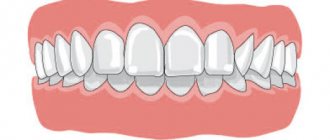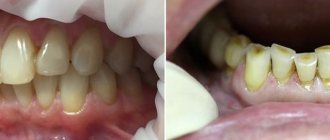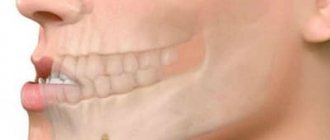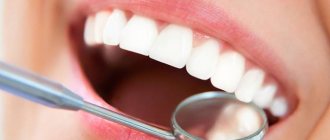Quite often in the practice of orthodontists, the following situation arises: they are approached by patients who have not thought about correcting their bite and sometimes did not even know that they had any problems, but were planning to install implants. But the implantologist refused to carry out treatment, referring him first to an orthodontist. Why is this happening?
The work of an implantologist and an orthodontist is connected, since the common goal is one - to bring the condition of the teeth as close as possible to ideal
To understand, you need to understand what is special about implants and how the bite affects them.
How are implants fundamentally different from other types of prosthetics?
Previously, prosthetics meant the installation of individual crowns or bridges. One crown can be installed on a dilapidated tooth, provided that its root is preserved. If a tooth is lost, you will have to grind down the nearest healthy teeth and install a bridge of crowns and an intermediate element on them.
A bridge consists only of crowns and an intermediate element; it does not replace the roots in any way
Although such prosthetics are still performed, it has disadvantages. Crowns functionally replace only the visible part of the tooth, allow chewing and return an attractive appearance to the smile, but do not restore the root of the tooth.
And when the roots of the teeth are lost, the jawbone gradually begins to thin out. The process of resorption (resorption) of bone tissue, which begins in all people after 35–40 years, occurs faster with tooth loss. The remaining teeth suffer from this.
The fundamental difference between implants is that they are installed in the bone, in place of the tooth root.
The most important stage in prosthetics is installation of the implant into the bone.
Thus, when chewing, the load is transferred to the implant, the jaw bone “responds” by supporting the renewal of bone tissue cells in this place. The functions of the tooth are fully restored, and there is no thinning of the jaw bone.
Therefore, implantation is in many cases the optimal method of prosthetics. But this is especially true for young people, those who are missing 1-2 teeth, and the rest are in good condition. It is implantation that will allow you to replace lost teeth in such a way that you can maintain the health of the remaining ones for many years.
Is it necessary to change the crown after orthodontic treatment?
Each case is individual. Sometimes the crown remains unchanged and there is no need to replace it with a new one. Making a new tooth is necessary only in the following cases:
- Deformation of the material, appearance of chips and cracks.
- After removing the braces, the crown began to wobble.
- The crown has changed color and stains have appeared that cannot be removed.
Only after the completion of orthodontic treatment can a conclusion be made whether it is necessary to replace the artificial tooth with a new one. If the prosthesis is made of plastic, the probability of damage to the product is about 90%. Ceramic crowns are more durable and can withstand the upcoming load.
But what do braces have to do with it?
An important feature of implants is that when chewing they experience stress, and it is transferred to the internal part (pin). Therefore, it is very important to correctly calculate the location of the implant and its angle of inclination. The crown that will be installed on the implant after healing must be in the correct position relative to the remaining teeth so that there is no increased load when closing. Otherwise, the implant will not last long.
Each implant has its own installation angle, which is calculated individually
Preparation for implantation includes modeling the process in a special program. This is a very important stage on which the success of treatment depends. And it is at this stage that a problem may arise: if the bite is incorrect, implants most often cannot be installed, since it simply will not be possible to do it correctly.
Implantation is a complex and expensive procedure. In good clinics, doctors give a guarantee for the work performed, and this, as a rule, is not 1 year, but much longer. Therefore, an experienced doctor will not undertake treatment for a malocclusion, since he will not be able to guarantee a good result.
Sometimes bite problems are not visible to the person himself; for example, with a direct or deep bite, the teeth can be straight and the smile looks generally attractive. But still, this creates a problem for implantation.
Example: teeth are straight, but the occlusion is incorrect
And although treatment by an orthodontist will seriously delay the day when prosthetics can be performed (by at least several months), this stage cannot be skipped.
Veneers - surgical correction of tooth defects
When it is necessary in the shortest possible time to correct the position of a deployed, protruded or creeping onto an adjacent tooth, to eliminate the gap between teeth or to disguise extensive fillings, wedge-shaped defects and restorations, microprosthetics with veneers . A miniature, thin ceramic plate is also made from an impression and applied to the front surface of the tooth using a special adhesive composition. The surface of the veneer is indistinguishable from tooth enamel in color and other characteristics.
The possibility of dental treatment and prosthetics under general anesthesia allows you to restore the integrity of teeth with inlays and veneers with minimal discomfort for the patient.
How to quickly and easily carry out treatment before implantation
Those who have not previously thought about treatment with an orthodontist are not motivated to wear braces, and this is understandable. But now, thanks to aligners, it is possible to undergo treatment in a short time. In addition, such an orthodontic system is invisible to others. Aligners are superior to braces in most important parameters and are best suited for preparation for implantation, since treatment with them is quick.
Preparation for implantation can take from several months to a year, depending on the initial situation. But such comprehensive treatment will bring benefits in the future, since with a correct bite it is easier to maintain healthy teeth.
It is better to correct the bite as early as possible. But if this does not work out, then you can contact an orthodontist at any age, even at 45–50 years old and later (nowadays older patients are not uncommon).
Material
The service life and characteristics of the product depend on the material of manufacture. Zirconium oxide structures are characterized by increased strength. Even titanium is inferior to this material in terms of strength.
Products are created from stainless steel, metal alloys, plastics, dental ceramics and combinations of materials.
Steel
Durable, technologically advanced and cheap material. Dental sockets are manufactured by stamping in laboratories or factories. The steel cap is open-forged to a configuration that matches the shape of the unit being restored. A coating of titanium nitride and a layer of ceramic or plastic is applied on top.
Due to low aesthetics, crowns are used on chewing elements.
Metal alloys
Combinations of cobalt, silver, titanium and gold are used. Products from refractory compositions are made by stamping, and from low-melting ones, casting and stamping technologies are used.
Prostheses made of noble metals are characterized by high biocompatibility with body tissues and long-lasting use.
Metal ceramics
A layer of ceramic is applied to the metal base, and the structure is fired in a kiln. The products combine the strength of metal and the aesthetics of ceramic composition.
Ceramics
Metal-free products are made from ceramics. They are highly aesthetic. Almost invisible in the oral cavity. Models made from durable types of dental ceramics are made using sintering, casting or sawing technology.
Metal-plastic
Models consisting of a metal base and a plastic layer. They are distinguished by functionality and aesthetics.
Stages of prosthetics
The procedure requires several visits to the dentist. Initially, the patient is examined, interviewed and examined. The doctor develops a treatment plan. The unit is then prepared. The dentist removes a layer of enamel from the tooth equal to the thickness of the crown wall. Local anesthesia is performed.
An impression of the dentition is taken and sent to a dental laboratory. The dental technician chooses the production technology depending on the type of prosthetic structure.
After making the prosthesis, the doctor fits the structure. Then grinding and polishing is carried out.
The prosthesis is fixed with cement. The stump and surface are first degreased and disinfected. At the last stage, the dentist removes excess cement.
Features of care
Crowns do not require special care. It is enough to observe daily oral hygiene and a gentle diet. It is recommended to get rid of the habit of smoking cigarettes.
Alternatives
Correcting the bite with crowns and other prostheses is called orthopedic correction. In addition to this, other methods of correcting the bite are also used.
- Muscle exercises.
- Fixed orthodontic devices.
- Mouthguards.
- Surgical intervention.
Exercises for the muscles of the face and mouth
In order to chew, swallow and breathe properly, it is necessary that the muscles of the mouth and face work correctly and in harmony with each other. Dysfunction of certain muscles and mismatch of their work lead to the development of malocclusions.
For example, if a child constantly breathes through his mouth, his chewing muscles become overstrained, which leads to a narrowing of the jaw.
The principle of myogymnastics is to train the maxillofacial muscles for the purpose of their proper functioning and the development of muscle memory. Muscle exercises are effective as preventative measures and easy correction of malocclusion.
Example. One of the exercises used in myogymnastics is training the orbicularis oris muscle. It is used for oral breathing of a child. A large plastic button is placed between the lips and held for a certain, gradually increasing time - from 1 to 3-5 minutes.
Orthodontic fixed devices
This method is called hardware. There are a huge number of orthodontic devices that differ from each other in indication, mechanism of action, and effectiveness. The most famous and most commonly used are braces.
The operating principle of the vast majority of modern braces is to act on abnormally located teeth by the elastic force of a metal arch, which is connected to braces attached to the enamel.
Braces are very effective orthodontic devices. They can correct anomalies of different types and severity in both children and adults. The main disadvantages of braces are the duration of treatment and high cost.
Mouth guards (trainers, aligners)
Mouth guards are removable polymer linings on the dentition, which, due to their elasticity and “shape memory,” exert a mechanical effect on groups of abnormally located teeth.
The simplest and most inexpensive type of mouthguards are trainers, designed to correct the bite in children (usually) and adults. Trainers are made of polyurethane or silicone, are removed for maintenance, and can be worn occasionally .
The most modern and effective aligners are aligners. These are devices made from transparent polymers using 3D modeling and printing.
Aligners are used in sets of up to 30 pieces, each subsequent aligner in the set has a greater force on the teeth than the previous one.
Unlike inexpensive trainers, treatment with aligners is expensive and not available to everyone.
Surgical correction of bite.
Surgical correction methods are used in complex clinical cases that cannot be corrected with hardware and other types of correction. Such anomalies can be severely dystopic teeth, open frontal, distal or mesial bite and others.
In the case of a dystopic tooth that interferes with the growth of other units, it is removed. In a mesial or distal bite, the mandible is moved forward or pushed back using bone grafting.
The operations are performed under general anesthesia. The patient returns to normal life after a few weeks. Surgery may be complemented by orthodontic treatment. For example, installing braces after the bone has healed.
Consequences of malocclusion
Improper closure of teeth makes the smile unsightly and negatively affects health: the load on the teeth is distributed unevenly, tooth enamel suffers - it wears off and becomes thinner. The gums under those teeth that are not involved in chewing gradually atrophy, exposing the neck of the tooth. Over time, teeth become loose and fall out.
Very often people neglect dental examinations. This continues until the situation becomes critical - the teeth are destroyed to such an extent that they have to be removed.











